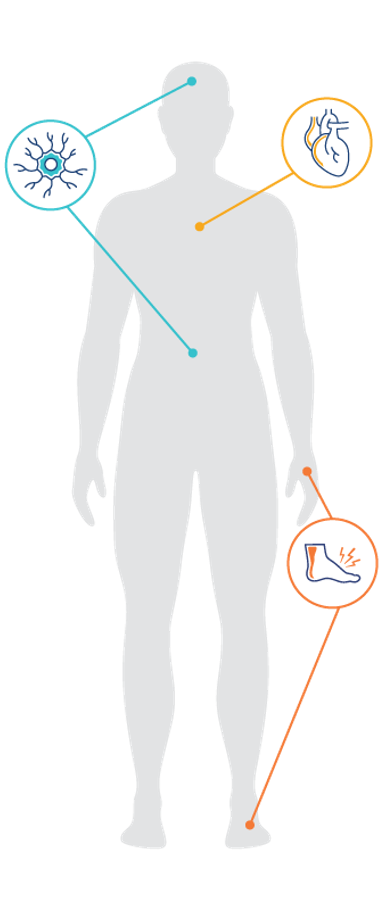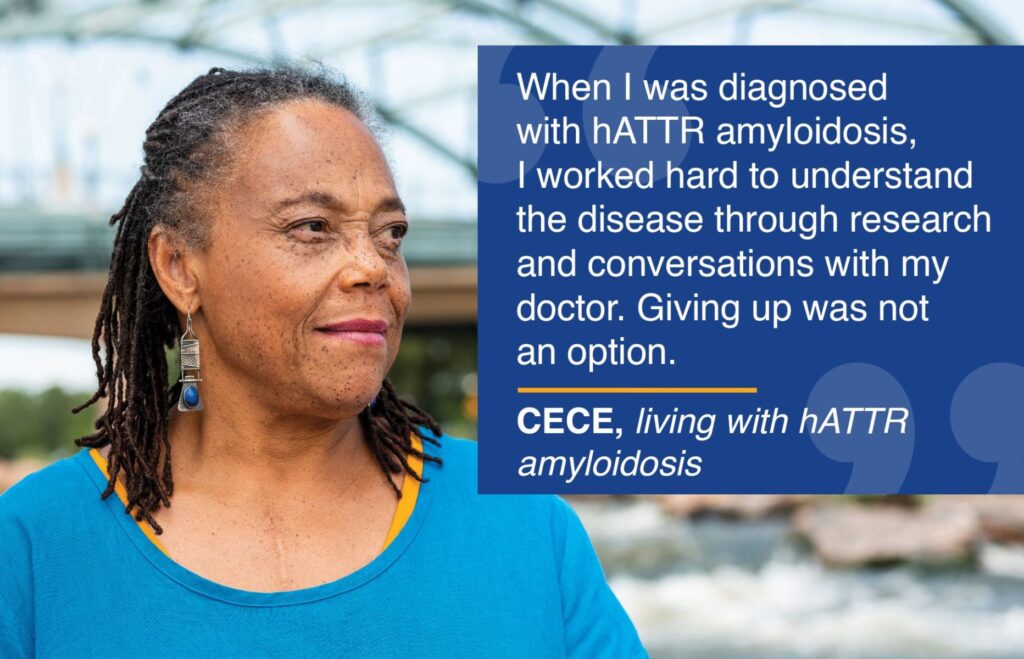“I have to be my own advocate, and you should be too,” said Christine, living with hereditary ATTR (hATTR) amyloidosis. “Once you know something, you can deal with it head-on. It’s the ‘not knowing’ that’s the most frustrating. Knowledge is power!”
Christine shared her inspiring story about being diagnosed with and living with hATTR amyloidosis during the Understanding the Connection Between Polyneuropathy and hATTR Amyloidosis program hosted by The Foundation for Peripheral Neuropathy (FPN) and Alnylam Pharmaceuticals. Members of The FPN community joined us for this program on September 28, 2023 to hear from Alnylam Patient Education Liaison Karen; Dr. Jeffrey Allen, a healthcare professional experienced in managing hATTR amyloidosis; and Christine, living with the disease. This program featured a review of hATTR amyloidosis–including genetics, family history, inheritance, and signs and symptoms of the disease like symptoms of polyneuropathy–and educational resources that are available to inform yourself with the facts about the disease.
hATTR Amyloidosis is a Genetic Condition that Runs in the Family
The disease is caused by an inherited gene variant, or change, in the transthyretin (TTR) gene. These variants affect the function of a protein called TTR, a naturally occurring protein that is made mostly in the liver.
In hATTR amyloidosis, a variant in the TTR gene causes the protein to take on an abnormal shape and misfold. This change in shape causes the protein to build up in various parts of the body, including the nerves, heart, and digestive system. The collections of abnormal proteins are called amyloid deposits and can cause symptoms of hATTR amyloidosis.

hATTR Amyloidosis Can Cause a Range of Symptoms Affecting Several Parts of the Body, Including the Nerves
The symptoms of hATTR amyloidosis can vary widely among people with the condition, even within families. The age that symptoms typically appear ranges from the mid-20s to the mid-60s. Because symptoms of hATTR amyloidosis can worsen over time, it’s important to talk to your doctor about them as soon as possible.

Symptoms related to the nerves in the hands, feet, arms, and legs include:
- Tingling
- Numbness
- Carpal tunnel syndrome
- Burning pain
- Loss of sensitivity to temperature
- Loss of movement control
- Weakness
Symptoms related to control over bodily functions include:
- Recurrent urinary tract infections
- Abnormal sweating
- Dizziness upon standing
- Sexual dysfunction
- Nausea and vomiting
- Diarrhea
- Severe constipation
- Unintentional weight loss
Fatigue, dizziness, shortness of breath, and leg swelling (edema) are symptoms related to the heart that are also seen in hATTR amyloidosis.
This is not a complete list of symptoms that may be experienced in patients with hATTR amyloidosis. Each patient has a different experience, and you may not experience all of these symptoms, or you may not experience them at the same time. Symptoms of hATTR amyloidosis may worsen over time.
Carpal Tunnel Syndrome may be One of the First Symptoms of hATTR Amyloidosis
Carpal tunnel syndrome may be one of the first symptoms of hATTR amyloidosis that people experience. This condition is common and causes pain, numbness, and tingling in the hands and arms. A significant number of people have symptoms of carpal tunnel syndrome up to 10 years before they show other symptoms of hATTR amyloidosis.
Carpal tunnel syndrome in hATTR amyloidosis often affects both hands, also known as bilateral, and specialized surgery is often required. However, in most people with hATTR amyloidosis, this surgery may not resolve their carpal tunnel syndrome, and signs of this condition may persist or reoccur after surgery.
Out of approximately 100 people who had carpal tunnel surgery in one study, 10 people had amyloid deposits and 7 of these people had TTR amyloid deposits. Two of these 7 people then received a diagnosis of hATTR amyloidosis based on genetic testing, which can help identify the disease.
Understanding how carpal tunnel syndrome is linked to hATTR amyloidosis could lead to an earlier diagnosis. If you think you are experiencing carpal tunnel syndrome, particularly in both hands, it’s important to start the conversation with your doctor about hATTR amyloidosis.
A Diagnosis that Affects the Whole Family
Because hATTR amyloidosis is passed down through family members, a diagnosis may also affect children and grandchildren. hATTR amyloidosis is an autosomal dominant condition–meaning each child of one parent with hATTR amyloidosis has a 50% chance of inheriting the genetic variant that causes the condition. A family member may inherit the TTR gene variant but having the variant does not necessarily mean that they will develop hATTR amyloidosis.
Although Anyone can be at Risk for this Disease, it is More Common for Certain Ethnicities
More than 120 different gene variants that can cause hATTR amyloidosis have been discovered. In the United States, the most common gene variants are V122I, T60A, and V30M. Different variants are often associated with specific sets of symptoms. However, each patient is different and may present with a wide range of symptoms.
The V122I variant more commonly affects African American patients in their 50s and 60s. Approximately 4% of African Americans are carriers of a V122I variant. Symptoms typically involve the nerves and heart. Nerve damage can lead to communication problems between the brain and the rest of the body, including the arms and legs. This may lead to a range of symptoms, including loss of voluntary movement of the hands and feet, and loss of sensitivity to temperature. Heart damage can lead to heart failure.
The T60A variant more commonly affects Irish patients in their early 60s. Symptoms often involve the nerves and heart.
The V30M variant more commonly affects Japanese and Portuguese patients in their 30s into their 60s. Symptoms typically involve the nerves. People of Portuguese descent may experience symptoms at a younger age. Eighty-seven percent of people of Portuguese descent, who were diagnosed with hATTR amyloidosis in one study, experienced symptoms before age 40.
Consider Genetic Counseling and Testing
If you experience symptoms or become aware of a family history of hATTR amyloidosis, speak to your doctor to find out the right action plan. If your doctor thinks you may be at risk for the disease, they may recommend you work with a genetic counselor. Genetic counselors are trained healthcare professionals who can:
- Work with people who are considering a genetic test and provide guidance after a test
- Help people understand genetics, inheritance, and potential implications of genetic testing
- Discuss the benefits, limitations, and potential implications of genetic testing
- Provide information about support and resources
A genetic test will determine whether a person carries a variant in the TTR gene associated with hATTR amyloidosis. If a gene variant is identified, family members of an affected person can use this information to help determine their own risk.
Alnylam Educational Resources

hATTR amyloidosis symptoms are similar to those of other conditions. Knowing what to look for can help you recognize symptoms sooner and work with your doctors to determine an accurate diagnosis.
One source of education that may be helpful are the Alnylam Patient Education Liaisons (PELs). Alnylam PELs are professionals with backgrounds in nursing, who can answer questions about hATTR amyloidosis and provide educational resources to help you and your family learn more about the condition. You can request to speak with an Alnylam PEL at www.hATTRPEL.com.
- The purpose of Alnylam Patient Education Liaisons (PELs) is to provide education to patients, their families, and caregivers
- PELs are employees of Alnylam Pharmaceuticals. They are not acting as healthcare providers and are not part of your healthcare team
- PELs do not provide medical care or advice
- All diagnosis and treatment decisions should be made by you and your doctor
Another educational resource that may be helpful is The Bridge. The Bridge is an Alnylam program designed to help raise awareness and provide education and helpful resources for patients, their families, and their caregivers. You can visit The Bridge at www.hATTRbridge.com to inform yourself more about hATTR amyloidosis and download educational brochures like the Symptoms Checklist & Tracker, which is a tool that you can use to monitor and track your symptoms.
Content sponsored and provided by Alnylam Pharmaceuticals.
The Bridge and its associated logo are trademarks of Alnylam Pharmaceuticals, Inc.
© 2024 Alnylam Pharmaceuticals, Inc. All rights reserved. TTR-USA-00398
